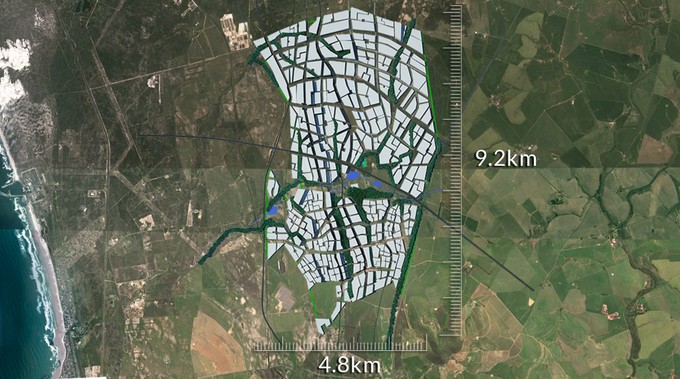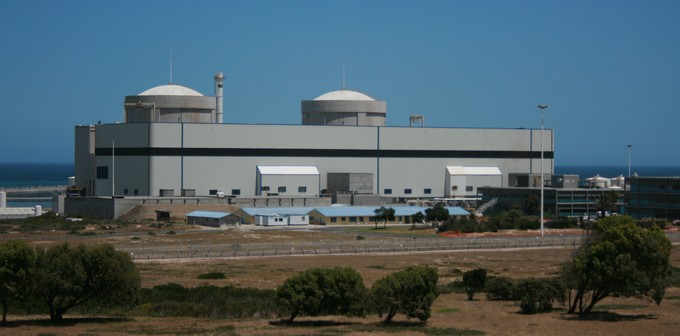Wescape: 800,000 people in Koeberg’s nuclear “red” zone?
Several City of Cape Town departments and Nuclear Regulator object to new project
The City of Cape Town has approved the creation of a new city of 800 000 people in 200 000 homes, 20 kilometres from Cape Town up the west coast. But many questions about the controversial new development remain unanswered. In the final article of a three part series, GroundUp reports on some of the objections to the project, including concerns that the new city would be within the Koeberg nuclear evacuation zone.
Read part one: Thriving new city or failed development?
Read part two: Who will finance the new city?
In January 2014 Western Cape Minister of Local Government, Environmental Affairs and Development Planning Anton Bredell announced the amendment to the urban edge to allow the huge Wescape development by communiTgrow. The council of the City of Cape Town had supported the amendment, in the face of objections from a number of City departments.
The amendment was also opposed by the National Nuclear Regulator (NNR) and the Koeberg Power Station.
In Bredell’s approval of Wescape’s application he conceded that there were concerns raised about the project but stated that these will be addressed “during the rezoning, environmental authorisation and subdivision applications”.
He said that one of the reasons behind his approval was reports that by 2021 the City would not have enough space for housing within its urban edge.
In 2012 various national and provincial departments submitted their response to Wescape’s application to amend the urban edge. Outright objections came from Koeberg Power Station, the NNR, and the City’s Disaster Risk Management, Fire emergency services, Water and Sanitation, Technical Services, Environmental Resource Management and Parks departments. None of the provincial departments officially objected to the application.
The City’s Human Settlements department supported the project and eight other City departments had no objection or did not comment.
Many responses called for more information or wanted clarification on issues such as bulk infrastructure and close proximity to Koeberg.
Despite this, Wescape’s developers saw the responses as “mainly positive” and said the information that some of the departments wanted would be provided during subsequent applications.
Rob McGaffin, who is a town planner and land economist, believes that the developers’ claim that the questions would be answered at a later stage “has just kicked the can further down the road”.
“Why would these issues somehow be able to be resolved with those applications? If they were resolvable why didn’t you just resolve them in terms of the urban edge application?” he asks.
He says that “unless there is some kind of alchemy” involved he does not see how the issues raised by the various departments will be resolved.
Nancy Odendaal, who is a senior lecturer in City Planning at the University of Cape Town and works with the African Centre for Cities, is concerned that the amendment to the urban edge was a mistake. The urban edge is there to protect encroachment onto agricultural land, to enable the city to densify and to ensure that infrastructure is not overly stretched, she says.
“It’s at a great cost to the city to do something like that,” says Odendaal.
In a letter written in 2013, a number of academics at the University of Cape Town said the amendment made “a mockery of the concept of urban intensification and the urban edge as an instrument to promote this”.
The academics also took issue with the fact that the amendment made a revision to what at the time was a newly concluded metropolitan spatial development framework – a document that they called “a social contract between the city and civil society”.

Agricultural land
A concern that has been raised is whether the development will take away agricultural land. Gita Goven, the chairperson of communiTgrow, says that although the land that Wescape is set to be developed on has been zoned agricultural, it has “not been productive for many years” and farmers have not been able to produce on it.
“When we did our application on the urban edge it was very important for us to have it checked quite thoroughly that the land doesn’t have agricultural use,” says Goven. She claimed that studies had made it “very clear that the land would be difficult to turn into arable land” and that farmers in the area were “completely happy” to sell their land.
This seems to contradict statements by the Acting Chief Director of Farmer Support and Development in the Western Cape Department of Agriculture, Mogale Sebopetsa, that “the land is under production and in line with the dairy and chicken commodities that are suitable for the type of the land and the farming environment”. He said there were “a lot of farming operations in the area”.
The Department of Agriculture requested a detailed agricultural survey among other things.
The City’s Environmental Resource Management department opposed the application citing that it “will result in a notable loss of agricultural land”.
Located in Koeberg “red zone”
Another major regulatory loop that Wescape’s developers will have to jump through is permission to build a city of 800,000 residents within the 16km zone around Koeberg power station, an area where development is limited due to the need to evacuate the area if there is a nuclear emergency.
The NNR’s submission said “such a large addition to the population in this area is completely unacceptable as it is inconceivable that such a large population could be evacuated and cared for in the event of an accident at Koeberg”. Koeberg made similar comments.
The NNR told GroundUp that discussions with Eskom, the City, the Province and affected parties were “at an advanced internal stage” and that the NNR “will be able to assess and have a more informed view on the matter when it receives detailed plans” from the City.
On Wescape’s website they assert that “relevant plans and guidelines are being factored into the spatial and movement design of Wescape” to correspond with an evacuation plan in case of emergency.
Unfortunately GroundUp did not get any response from the City of Cape Town to our questions regarding Wescape, as their media department said that because an Environmental Impact Assessment has yet to be lodged it did not have any information to respond to our questions.

Support independent journalism
Donate using Payfast

Don't miss out on the latest news
We respect your privacy, and promise we won't spam you.
© 2016 GroundUp. 
This article is licensed under a Creative Commons Attribution-NoDerivatives 4.0 International License.
You may republish this article, so long as you credit the authors and GroundUp, and do not change the text. Please include a link back to the original article.

